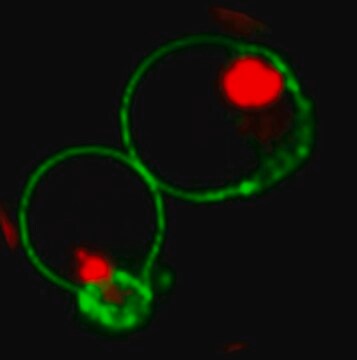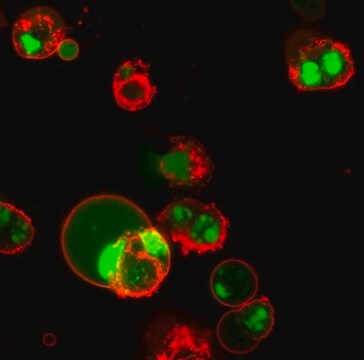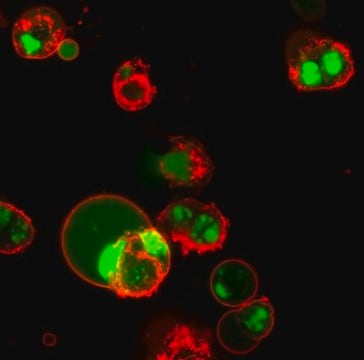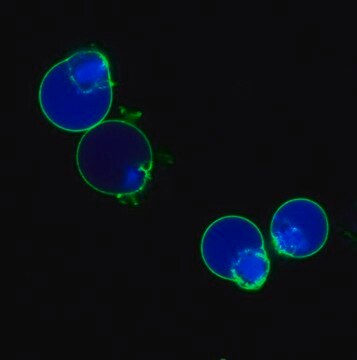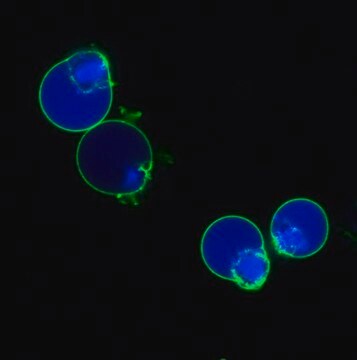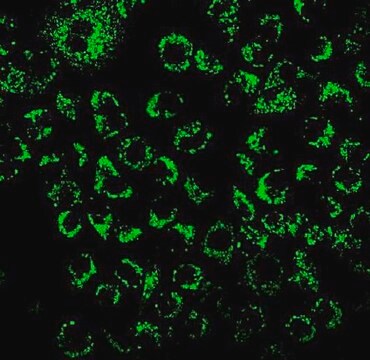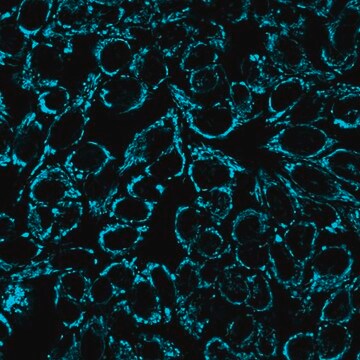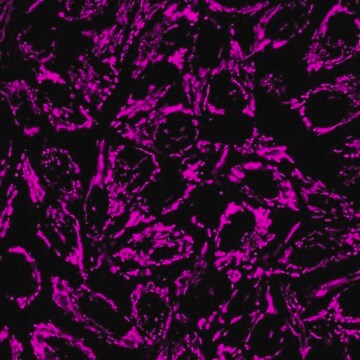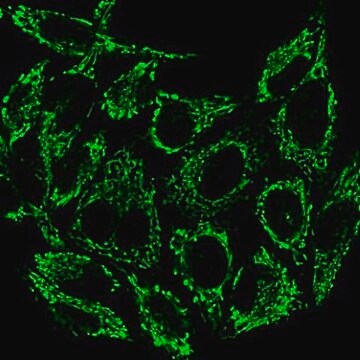SCT103
BioTracker NucView® 530 Red Caspase-3 Dye (DMSO)
Live cell imaging apoptosis dye for caspase-3/7 enzyme activity used to detect programmed cell death using fluorescence microscopy or flow cytometry applications.
Synonim(y):
Live cell imaging probe
Zaloguj sięWyświetlanie cen organizacyjnych i kontraktowych
About This Item
Kod UNSPSC:
12352207
NACRES:
NA.47
Polecane produkty
metody
cell based assay: suitable
metoda wykrywania
fluorometric
Warunki transportu
ambient
Opis ogólny
Caspases are a family of protease enzymes that play essential roles in programmed cell death, termed apoptosis. Caspase-3 is a caspase protein that interacts with caspase-8 and caspase-9 and sequential activation of plays a central role in the execution-phase of cellular apoptosis.
The BioTracker NucView 530 Red Caspase-3 Dye provides a convenient live cell tool for profiling apoptotic cell populations based on caspase-3/7 activity using either fluorescence microscopy or flow cytometry. In contrast to other fluorogenic caspase substrates or fluorescent caspase inhibitor based (FLICA) assays, the BioTracker NucView 530 Red Caspase-3 Dye can be used to detect caspase-3/7 activity within individual intact cells without inhibiting apoptosis progression. The substrate consists of a fluorogenic DNA dye coupled to the caspase-3/7 DEVD recognition sequence. The substrate, which is initially non-fluorescent, penetrates the plasma membrane and enters the cytoplasm. In apoptotic cells, caspase-3/7 cleaves the substrate, releasing the high-affinity DNA dye, which migrates to the cell nucleus and stains DNA with bright red fluorescence. Thus, NucView 530 Caspase-3 Substrate is bifunctional, allowing detection of caspase-3/7 activity and visualization of morphological changes in the nucleus during apoptosis. The dye is formaldehyde-fixable and compatible with subsequent immunostaining. The dye is offered in DMSO and PBS (phosphate-buffered saline) formulations. The substrate in PBS is formulated for use in cells that are sensitive to DMSO toxicity.
NucView 530 Caspase-3 Substrate stains apoptotic cell nuclei with orange fluorescence, for detection in the Cy3 channel by fluorescence microscopy or the PE channel by flow cytometry. Note that when excited by the 488nm laser line, NucView 530 also fluoresces in the FITC channel, and therefore cannot be analyzed together with green probes by flow cytometry.
Spectral Properties
Absorbance: 528nm
Emission: 563nm
The BioTracker NucView 530 Red Caspase-3 Dye provides a convenient live cell tool for profiling apoptotic cell populations based on caspase-3/7 activity using either fluorescence microscopy or flow cytometry. In contrast to other fluorogenic caspase substrates or fluorescent caspase inhibitor based (FLICA) assays, the BioTracker NucView 530 Red Caspase-3 Dye can be used to detect caspase-3/7 activity within individual intact cells without inhibiting apoptosis progression. The substrate consists of a fluorogenic DNA dye coupled to the caspase-3/7 DEVD recognition sequence. The substrate, which is initially non-fluorescent, penetrates the plasma membrane and enters the cytoplasm. In apoptotic cells, caspase-3/7 cleaves the substrate, releasing the high-affinity DNA dye, which migrates to the cell nucleus and stains DNA with bright red fluorescence. Thus, NucView 530 Caspase-3 Substrate is bifunctional, allowing detection of caspase-3/7 activity and visualization of morphological changes in the nucleus during apoptosis. The dye is formaldehyde-fixable and compatible with subsequent immunostaining. The dye is offered in DMSO and PBS (phosphate-buffered saline) formulations. The substrate in PBS is formulated for use in cells that are sensitive to DMSO toxicity.
NucView 530 Caspase-3 Substrate stains apoptotic cell nuclei with orange fluorescence, for detection in the Cy3 channel by fluorescence microscopy or the PE channel by flow cytometry. Note that when excited by the 488nm laser line, NucView 530 also fluoresces in the FITC channel, and therefore cannot be analyzed together with green probes by flow cytometry.
Spectral Properties
Absorbance: 528nm
Emission: 563nm
Zastosowanie
Live cell fluorescent imaging
Live cell imaging apoptosis dye for caspase-3/7 enzyme activity used to detect programmed cell death using fluorescence microscopy or flow cytometry applications.
Research Category
Cell Imaging
Cell Imaging
Research Sub Category
Live Cell Dye
Live Cell Dye
Jakość
Spectral Properties
Absorbance: 528nm
Emission: 563nm
Absorbance: 528nm
Emission: 563nm
Postać fizyczna
Liquid
Przechowywanie i stabilność
Store BioTracker NucView 530 Red Caspase-3 Dye, 1mM in DMSO at 2-8ºC. Protect From Light.
Note: Centrifuge vial briefly to collect contents at bottom of vial before opening.
Note: Centrifuge vial briefly to collect contents at bottom of vial before opening.
Informacje prawne
NucView is a registered trademark of Biotium Inc.
Oświadczenie o zrzeczeniu się odpowiedzialności
Unless otherwise stated in our catalog or other company documentation accompanying the product(s), our products are intended for research use only and are not to be used for any other purpose, which includes but is not limited to, unauthorized commercial uses, in vitro diagnostic uses, ex vivo or in vivo therapeutic uses or any type of consumption or application to humans or animals.
Ta strona może zawierać tekst przetłumaczony maszynowo.
Kod klasy składowania
10 - Combustible liquids
Klasa zagrożenia wodnego (WGK)
WGK 1
Temperatura zapłonu (°F)
188.6 °F - (refers to pure substance)
Temperatura zapłonu (°C)
87 °C - (refers to pure substance)
Certyfikaty analizy (CoA)
Poszukaj Certyfikaty analizy (CoA), wpisując numer partii/serii produktów. Numery serii i partii można znaleźć na etykiecie produktu po słowach „seria” lub „partia”.
Masz już ten produkt?
Dokumenty związane z niedawno zakupionymi produktami zostały zamieszczone w Bibliotece dokumentów.
Nasz zespół naukowców ma doświadczenie we wszystkich obszarach badań, w tym w naukach przyrodniczych, materiałoznawstwie, syntezie chemicznej, chromatografii, analityce i wielu innych dziedzinach.
Skontaktuj się z zespołem ds. pomocy technicznej